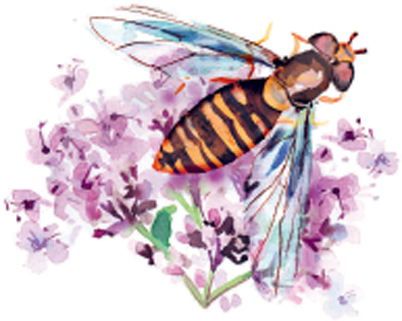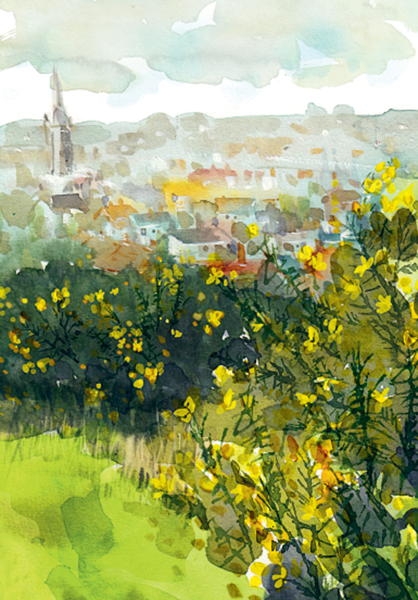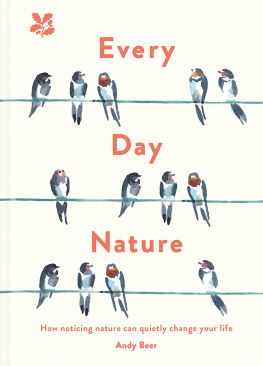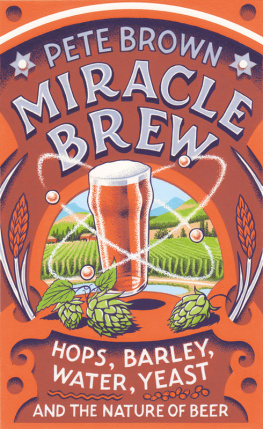Andy Beer - Every Day Nature
Here you can read online Andy Beer - Every Day Nature full text of the book (entire story) in english for free. Download pdf and epub, get meaning, cover and reviews about this ebook. year: 2020, publisher: Pavilion Books, genre: Science. Description of the work, (preface) as well as reviews are available. Best literature library LitArk.com created for fans of good reading and offers a wide selection of genres:
Romance novel
Science fiction
Adventure
Detective
Science
History
Home and family
Prose
Art
Politics
Computer
Non-fiction
Religion
Business
Children
Humor
Choose a favorite category and find really read worthwhile books. Enjoy immersion in the world of imagination, feel the emotions of the characters or learn something new for yourself, make an fascinating discovery.
Every Day Nature: summary, description and annotation
We offer to read an annotation, description, summary or preface (depends on what the author of the book "Every Day Nature" wrote himself). If you haven't found the necessary information about the book — write in the comments, we will try to find it.
Every Day Nature — read online for free the complete book (whole text) full work
Below is the text of the book, divided by pages. System saving the place of the last page read, allows you to conveniently read the book "Every Day Nature" online for free, without having to search again every time where you left off. Put a bookmark, and you can go to the page where you finished reading at any time.
Font size:
Interval:
Bookmark:




There is a common turn of phrase that turns up a lot in books about nature, which goes something like this: If you are really lucky then you may catch a glimpse of a bearded tit/otter/purple emperor butterfly (delete as applicable).
I am sorry to break it to you, but no, you wont. What these books should say is: If you accompany an expert to exactly the place where these rare things are found, at exactly the right time of year and you look where the expert is pointing then you might have a chance of seeing the rear end of the creature in question as they fly away/dive under the water.
I have been fascinated by nature for most of my life, but there are still lots of things I have never seen. So, this type of advice is not only discouraging, it also reinforces that sense that being interested in nature is simply a quest to fill in some long list, perhaps in the hope of a prize. There is always something brighter, rarer, more exciting just around the next corner.
Somehow nature has become the preserve of the experts. You have to appreciate it in a prescribed way, with the right equipment. You have to get the names right (dont call it a seagull). You are required to dismiss some beautiful things because they are not native or invasive, which is ironic, given that just about everything that lives in this country had to invade after the ice last retreated fifteen thousand years ago.
This book is about another way to watch nature. It is about noticing the commonplace, marking the cycle of the seasons and taking time to study things closely. Its not about heading off to distant parts in order to find a creature; rather it is about looking at what is under your nose, and in writing this book I have had to spend time re-educating myself about the apparently simple business of how to see.
The book is inspired by the work of an eighteenth-century vicar. Gilbert Whites The Natural History of Selborne followed the turning of each year for more than two decades. Aside from time and a great sense of curiosity, the Reverend had the great advantage of not being distracted by rolling news from far away. So the eve of the declaration of American independence is greeted by an observation about the cherry-stealing habits of blackcaps. The storming of the Bastille passes him by while meditating on the habits of nightjars. I am not persuaded that he was much the poorer for it.
While writing, I too have ignored the news in favour of a daily dose of nature. It has reminded me how essential that is for my own wellbeing. Like many people, I find the descent into the dark days of winter saps my spirits and causes me to hunker down. The antidote is to notice things and take delight in them, to get as much fresh air as you can, stomp outside in the rain, go out on a freezing dark night.
We have somehow come to think of nature as something fragile that lives far away. Instead it is something huge and powerful that is all around us. If we take the time to slow down and observe, then the turning of the seasons can add great meaning to our lives. Looking at nature is also a helpful antidote to our own self-absorption. It reminds us that we live on a small island on the north-western fringe of a giant continent many of the things we see in our gardens have travelled half the world to be here.
This book is meant as an inspiration to help you find and enjoy nature wherever you may live. It is not about the kind of nature that is restricted to nature reserves or remote places. Instead it is deliberately about things you will find in a garden, a park, a hedgerow or a road verge.
Expertise is not required; in fact it is overrated. You dont have to know exactly what something is called to appreciate it. Let me say that again: you dont have to know exactly what something is called to appreciate it. Curiosity and imagination are the currency of this book.
Notice a little bit of nature every day. It may change your life

Gorse bushes.
What is there to commend the month of January?
It can be a month of leaden skies and wild winds. Birds flock in gardens and field edges hunting for food and shelter. Bones of hawthorn hedges clatter in the winter breeze.
Yet, when the wind turns east, there can be glorious, crisp days with air so dry that it catches your breath and the crunch of a frozen puddle underfoot.
This is a time to appreciate the skeleton-spare beauty of winter, bark and branch, stone and soil.
Although it doesnt feel like it, we are imperceptibly tilting back towards the sun each day. If you look carefully enough, nature is beginning to waken.
We are in the depths of winter, but let me tell you the nature watchers secret: spring starts in January. You have to look carefully, but as the year turns you can step outside and find something that tells you that the long nights are coming to an end and that the heat of the sun is slowly returning.
If you can watch a little bit of nature every day in January then the rest of the year is going to be a breeze. You have to work much harder to find nature in the winter, but that makes what is there all the sweeter.
So, today is the day to start as you mean to go on and force yourself outside for a breath of air as the rain pours and the wind howls. Walk, run, hop on a bike whatever suits you but get outside you must, even if it is just for a few minutes.
Keep your eyes open as you go: for although they are subtle, this month contains all sorts of little milestones that mark the turning of the year.
I have a charm of goldfinches before me; clustered on a bird feeder, they are as charming as can be. Its hard to believe that these exotic birds, with heads of red, white and black and the brightest flash of gold on each wing, can just materialise in our gardens.
If you do nothing else this year then try to feed a goldfinch. This is the thistle finch, with a pointed beak for extracting tiny seeds from spiky flower heads. Goldfinches absolutely love little black niger seeds. Wherever you live, your feeder may bring you a finch one day.
News seems to travel fast among goldfinches. They are a constantly twittering gang, so advertising your feeder will not be necessary word of mouth (or beak) will suffice. In fact the word for a flock of goldfinches, a charm, derived from cirm or cyrm, the Old English word for this twittering song.
Its said that you should kiss your beloved when the gorse is in flower. Happily, you could even find a flower now on wasteland or a common or tucked in beside a wall and the whole of the rest of the year too if you are so minded.
Even among the snow, the lemon-yellow flowers scatter the fringes of these dark, spiny bushes. Be warned though, they are fiercely prickly.
Font size:
Interval:
Bookmark:
Similar books «Every Day Nature»
Look at similar books to Every Day Nature. We have selected literature similar in name and meaning in the hope of providing readers with more options to find new, interesting, not yet read works.
Discussion, reviews of the book Every Day Nature and just readers' own opinions. Leave your comments, write what you think about the work, its meaning or the main characters. Specify what exactly you liked and what you didn't like, and why you think so.












